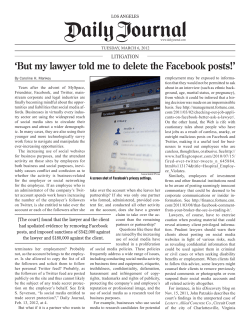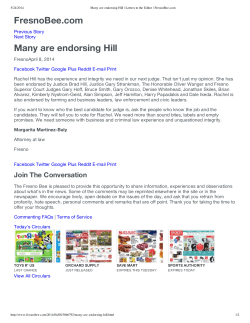
Social marketing is the wave of the
Social marketing is the wave of the future. Find out how to get in the game and become a social media star. BY CAROL M. BAREUTHER, RD F riend or Fan. Like or digg? Tweet. Blog. This is the lingo of social media, the latest tool to add to your company’s comprehensive marketing tool box. If you think this interactive communications medium isn’t for you or won’t translate into profits, think again. According to Social Media Revolution Refresh, released May 5, 2010, by ClickZ, a New York, NY-based interactive marketing news company, “We don’t have a choice on whether we do social media; the question is how well we do it.” Social media marketing is definitely growing. It’s word of mouth on steroids, or in other words, fast becoming world of mouth. According to a June, 2010, analysis by the New York, NY-based Nielsen Company, 75 percent of Internet users worldwide visit a social network or blog when they go online, marking a 24 percent increase over the prior year. Valued in another way, in 2010, new media marketing market’s worth totaled $37.6 billion, with the greatest growth from 2008 to 2010 in social network marketing, up 140 R E P R I N T E D W I T H P E R M I S S I O N F R O M P R O D U C E B U S I N E S S , F E B RUA RY 2 0 1 1 . W W W. P R O D U C E B U S I N E S S . C O M 17 “What’s it worth to know why people buy your product or not? Social media is like a real time focus group, only more affordable and more accessible.” — DAN’L MACKEY ALMY DMA SOLUTIONS percent, according to the Attitudes to Internet and New Media Marketing report, released by the Chicago, IL-based Mintel International Group Ltd., in October, 2010. new mediums correctly to reach their target market are experiencing profitable gains.” “Correctly” means using social media to create interactive dialogues with customers. In other words, social interaction first, selling second. However, buying and selling is what the produce industry is traditionally all about. Karen Caplan, president and CEO of Frieda’s Inc., in Los Alamitos, CA, maintains, “The big challenge in the produce industry is to make social media relevant.” “Relevance, or applicability,” says Almy, “comes in using the opportunity to connect with the consumer to enrich relationships and discussions with buyers. Imagine talking to a buyer at Kroger, for example, and telling him or her that you have 5,000 Facebook fans and 2,000 of them are in Cincinnati, or that 70 percent of your followers are men and here’s what they’re saying about our product. Social media literally can work just like this.” What Is Social Media Marketing? Why Do It? Put Social Media To Work “The ‘birth’ of social media as a bona fide business tool has come to the fore in the past couple years,” says Veronica Kraushaar, president of Viva Global Marketing LLC, in Nogales, AZ. “Today, we see the Queen of England joining Facebook with over 100,000 followers in just two days...so it has caught on even with the ultra-traditional.” “Access, speed and immediacy is what has caused social media to really take off,” maintains Dan’l Mackey Almy, president and managing partner of DMA Solutions Inc., based in Irving, TX. “Technology is so much a part of our daily lives today. It’s created an opportunity for consumers to learn about products and control their purchase decisions.” Julia Stewart, former public relations director for the Newark, DE-based Produce Marketing Association (PMA), asserts, “Consumers want to know the face behind their food — not what we do, but why we do it. Social media provides the venue for our industry to connect with consumers and make these substantial and impactful connections.” “Interest in social media within the produce industry is growing quickly,” reports John Avola, marketing and internet development manager for Orlando, FL-based Produce for Kids (PFK). “This growth is evident through the recent increase in produce companies on various social media platforms.The companies that are using these “There are several marketing opportunities of each type of social media,” explains Avola. “All of these networks require the motivation to try new marketing techniques. Any company can take advantage of social media. The resources are available to everyone and the cost is minimal. The difference is how companies use these platforms to leverage their goals.” Facebook, launched in 2004, is an Internet-based tool that can increase brand loyalty, strengthen communication and build awareness. After Google and MSN/Windows Live, Facebook is the third most popular online brand, with 54 percent of the world’s internet population visiting this site, according to a June, 2010, analysis by the Nielsen Company. Elizabeth Pivonka, president and CEO of the Hockessin, DE-based Produce for Better Health (PBH) Foundation, reports, “We have three Facebook pages. One is for consumers. This is where we spend most of our time, both community-building and starting conversations. There are over 2,000 fans. The other two Facebook pages are for PBH Foundation members, which let industry and intermediaries know what is happening and what is available. The other page is for our catalogue of educational material that can be purchased by customers.” PFK’s Facebook page welcomed more than 1,300 followers — parents, produce suppliers, retailers, media and Registered 18 Dietitians — in its first year of launch. The Dole Fresh Fruit Co. maintains three dedicated Facebook pages. Bil Goldfield, the Westlake Village, CA-based communications manager, says, “Facebook has allowed consumers to connect with the products they are passionate about through our Dole Bananas and Dole Salads pages. These same fans and others are also able to find and share a wealth of knowledge about health and nutrition at the Dole Nutrition page.” The DOLE Salad Guide personality serves as the voice of the company’s salads Facebook as well asTwitter pages, educating consumers about products and encouraging them to widen their salad horizons and inkitchen creativity in a variety of ways. Chris Mayhew, the director of marketing for Dole Fresh Vegetables Inc., also based in Westlake Village, CA, says, “I think this personal touch has helped to make these touch points significantly more accessible and compelling than traditional brand-only pages.” Dole’s banana and salad Facebook pages have more than 350,000 and 150,000 fans, respectively, while the nutrition page has over 190,000 additional fans. Kristen M. Stevens, senior vice president at PBH, describes, “On our consumer Facebook site we’ll post recipes. If we’ve recently put on short consumer articles such as on fads or myths about fruits and vegetables, we’ll post these here. We’ll also post tips and hot topics. The topic of the day changes; it’s not static.” Twitter, founded in 2006, is a microblogging community that offers the opportunity to connect to a mass audience through 140 character messages. According to the company’s Web site, twitter.com, there are 190 million Twitter users worldwide who generate 65 million tweets daily. “The benefit of twitter is being able to deliver short bits of information in real time,” says Robert Schueller, director of public relations for Melissa’s/World Variety Produce, in Vernon, CA. “For example, I tweeted about Cocktail grapefruit the first day they became available this season. Typically, I’ll announce the product is available and give a Web site at the end for customers to go to for more information.” Pivonka says, “We have two Twitter accounts. One is for consumers and the other is for the industry. Over 2,700 followers follow our consumer-oriented Twitter feeds.” Barbara Ruhs, corporate dietitian for R E P R I N T E D W I T H P E R M I S S I O N F R O M P R O D U C E B U S I N E S S , F E B RUA RY 2 0 1 1 . W W W. P R O D U C E B U S I N E S S . C O M Bashas’ Inc., a 166-store chain based in Chandler, AZ, tweets daily, sometimes several times a day. For example, the week prior to Thanksgiving, Ruhs tweeted the availability of a healthful green bean casserole recipe. She appended the Twitter icon on the California Walnut Board’s Web site, where the recipe was located, to her tweet to lead followers to the recipe. Twitter is ideal to instantly deliver instore offers, last-minute deals and events. Ruhs points out, “Consider that I’m sitting here in November writing produce ads for our January and February circulars. With Twitter, I can read or see something today and call it out instantly.” Twitter accounts allow the tweeter to follow and be followed by other Twitter users. Samantha Cabaluna, director of communications at Earthbound Farm, in San Juan Bautista, CA, says, “Our goal is to establish a reputation for always following cool people in the food world so more people will want to follow us. This gives us an opportunity to broaden our reach.” Twitter can be a conduit to a major marketing opportunity. For example, when Brianna Shales, communications manager for Stemilt Growers LLC, in Wenatchee, WA, answered a question posed by someone she followed on Twitter, the response led to an invitation for Shales to appear as a guest on a local TV station news program where she spoke about one of the grower’s new apple varieties. YouTube, a video-sharing Web site started in 2005, is becoming a search engine with the ability to influence a global audience through visual updates and demonstrations. Forty-two percent of the global internet population visits this site, according to a June, 2010, analysis by the Nielsen Company. Reader Service # 71 — TANIOS VIVIANI CHIQUITA BRANDS INTERNATIONAL INC. Tanios Viviani, president of global innovation and emerging markets and chief marketing officer for Chiquita Brands International Inc., in Cincinnati, OH, asserts, “This is a great outlet to show the more fun and relaxed side of the company. People who view our YouTube videos are able to catch a glimpse into life at Chiquita, which helps to personalize the brand. The only difficulty we face as a company with YouTube is the ability to remove content once it is posted. The broadcast of handling tips, preparation methods and usage instructions as well as humor and trivia is the goal of Frieda’s Produce channel on YouTube. Topics to date, produced by in-house marketing staff,minclude jicama, Bitter melon, Bloodoranges, Kiwano melon and Cactus pears. Viewers are urged to sign up to receive notification of new videos, which are posted monthly. A blog, or web-based log usually written by an individual or blogger, is a way to give a voice to a company. Frieda’s Caplan says, “My twice-weekly blog addresses the mission of our company, changing the way Americans eat fresh fruits and vegetables, but isn’t a direct sell. I might talk about a product or maybe obesity, a shopping experience or new restaurant I’ve tried, something that resonates around produce.” In a different tact, Dole hosted its first Food and Wellness Blogger Summit this past year. Twenty of the most influential food, health, nutrition and wellness bloggers were invited to take an inside look at the company and hear brand presentations, nutritional panel discussions and see newproduct demos from the Dole test kitchens. “With so much focus on the major social media Web sites,” says PFK’s Avola, “the opportunity to join a niche community is lost. For example, Ning is a platform used for creating and joining niche social networks. There is already a produce network establish called ‘ProduceCommunity’ where those involved in the produce industry discuss what is important to them.” Dos And Don’ts Of Social Marketing Don’t think social media marketing is free, even though there’s no fee to set up a Facebook or Twitter account or post a video on YouTube. Wendy Brannen, executive director of the Vidalia Onion Committee (VOC), in Vidalia, GA, says, “Setting up an effective social media R E P R I N T E D W I T H P E R M I S S I O N F R O M P R O D U C E B U S I N E S S , F E B RUA RY 2 0 1 1 . W W W. P R O D U C E B U S I N E S S . C O M Reader Service # 21 “This is a great outlet to show the more fun and relaxed side of the company. People who view our YouTube videos are able to catch a glimpse into life at Chiquita, which helps to personalize the brand.” 19 “We’re beginning to develop a history of what posts, tweets and content works, and what isn’t as compelling. Our fans are much more inclined to want to engage in a question than a comment, and recipes are still king. When it comes to cooking, salad preparation and pairings, and even the latest banana desserts, folks want to share their own secrets.” — CHRIS MAYHEW DOLE FRESH VEGETABLES INC. media is like a real time focus group, only more affordable and more accessible.” Make an effort to integrate all your marketing strategies. Avola reminds, “No one channel of social media is an island. It’s key to have an integrated marketing campaign. Each network does something different and not all people are on all media.” A good example of an integrated social media campaign is Chiquita’s Undercover Boss promotion. Viviani details, “We created a specific Undercover Boss tab on Facebook, holding trivia contests on Facebook the week leading up to the Chiquita episode air date and having Chiquita’s CEO tweet the week leading up to the show, and then posting video clips on our YouTube page.” However, just because you have engaged in social media, don’t stop using traditional forms of marketing such as newspaper, radio and TV ads. Avola advises, “Instead, include them into your social media campaign.” Bashas’ Ruhs also offers a good example: “If we have strawberries in the circular this week, I might tweet where followers can find a healthful way to prepare strawberry shortcake.” Update your Web site. According to Almy, “Web sites are now home base to connect through rather than the electronic brochures they served as five years ago. Reader Service # 40 program takes time and money. You have to monitor and participate, be active and proactive, and this is where you’re expenses lie. Even after you pay your web person to do a nice Facebook or Twitter page, you can’t just leave it alone.” Continually engage your friends and fans. Earthbound Farm’s Cabaluna says, “Social media is our digital front porch where everyone congregates to chat. Therefore, you can’t post something every six months and expect people to follow you. You’ve got to be responsive, engaged, conversational and committed. Not everything you hear may be flattering, but how and when you respond says something about you as a company.” PBH’s Stevens acknowledges, “One of the key things we learned is the right number of times to post on Facebook. We’re typically posting six to 12 times per week. The key to posting is to do it often enough to interest consumers and keep them coming back, but not so often as to annoy them. It’s a juggling act.” Listening is as important as talking, adds DMA’s Almy. “What’s it worth to know why people buy your product or not? Social 20 R E P R I N T E D W I T H P E R M I S S I O N F R O M P R O D U C E B U S I N E S S , F E B RUA RY 2 0 1 1 . W W W. P R O D U C E B U S I N E S S . C O M FIVE STEPS TO SUCCESSFULLY IMPLEMENTING SOCIAL MARKETING to boost your Facebook fan base, generate some buzz, and increase word-of-mouth sharing, since people will share good deals with their friends,” says Chiquita’s Viviani. S ocial marketing is making the turn from experimentation to implementation. However, says John Avola, marketing and internet development manager for Orlando, FL-based Produce for Kids (PFK), “Most produce companies today understand the benefits of social media, but struggle with implementing an effective strategy.” Here is Avola’s five-step strategy: 1. Research and understand your target audience. Do you want to sell apples to children? Target moms. Without accurately defining your target customer, the other steps are difficult and can cause you to continually rework your plan. 2. Identify your strategy. Brainstorm. Then write down on paper what it is exactly your company wants to communicate to consumers. 3. Select the best social media platform to accomplish your goals. Remember that different social networks attract different audiences. 4. Join the conversation. Research done, strategy defined, platform chosen, now is the implementation stage. Open accounts and start interacting. Work on gaining the fans and followers that you’ve targeted. Spread the word. 5. Measure and reevaluate. Are you reaching your target market? Is the strategy working? It’s very important to be flexible, restrategize and make adjustments, stresses Avola. “Something new happens every day in the social media world so your plan will never be final. It will always be a pb work in progress.” This means Web sites need to be dualspeak to both buyers and consumers. Position information differently. For example, rather than pack sizes, post recipes or other tips on storing, handling and using your products.” Try couponing through social media. Elena Hernandez, marketing coordinator for Mann Packing Co. Inc., in Salinas, CA, says, “We see social media as a cost-effective way to build more exposure for coupons. For example, we can remind customers on Facebook about an on-pack offer for sugar snap peas.” “Couponing is pretty much guaranteed Measuring Success “Social media is similar to public relations and consumer relations management in that a specific link to sales is hard to measure,” points out Dole’s Goldfield. “The opportunity lies in being able to build relationships with consumers within a larger community of passionate followers, which, in turn, builds loyalty. Our true metrics are viral engagement. At the end of the day, while we may not be able to measure it precisely, we can assume there to be a very positive link between sales and conversations with an engaged community.” “Some of the metrics used to measure success depend on the goals of a social media marketing campaign,”says Viviani.“These can include ‘engagement metrics’ such as number of contest submissions, coupon redemption, number of Facebook shares/likes/posts/ comments, to name a few.” As an example, over 2,000 people took PFK’s first-ever Play with Your Produce Facebook Quiz. The quiz encouraged Facebook users to take a 10-question test that matched their personalities to a specific type of produce. PFK’s Avola says, “One measure of success is the increase in fans and followers. Our Facebook fans increased by more than 500 percent in 2010 compared to 2009. Fans are tangibly valuable. According to a June, 2010, released SocialTRAC study published by the NewYork-based Syncapse Corp., on average, fans spend an additional $71.84 on products for which they are fans compared to those who are not fans. In addition, fans are 28 percent more likely than non-fans to continue using the brand, and fans are 41 percent more likely than non-fans to recommend a fanned product to their friends. Beyond fan-tracking, some companies such as Viva Marketing measure the traffic, links and other stats tracked by its blog host. “We can readily see which subjects are hits and which are misses through these stats. But the best measurement is when our retail followers read a post about, say, now being the ideal time to promote cucumbers, and they pick up the phone and place an order.” Some metrics of success are less direct, however. Brannen of the VOC says, “Our second highest tweeted response in August was about storing and handling tips for Vidalia onions. This was important information to us because it meant consumers were going out and buying the end-ofseason crop to store.” Chiquita’s Viviani adds, “If your ultimate goal is brand-building, and moving the needle on business is only an added bonus or secondary goal, then you would focus more on awareness and engagement metrics. There are ways to track the sales impact of a campaign, but it can be a bit tricky to determine or measure the sales impact of a campaign when that campaign is marketing an entire brand as opposed to a specific product.” The Future Of Social Marketing With a year or more of social marketing programs underway for some produce companies, what has been learned so far? Dole’s Mayhew says, “We’re beginning to develop a history of what posts, tweets and content works, and what isn’t as compelling. Our fans are much more inclined to want to engage in a question than a comment, and recipes are still king. When it comes to cooking, salad preparation and pairings, and even the latest banana desserts, folks want to share their own secrets. In addition, we knew that consumers in their 20s and 30s would embrace the technology, but also had a hunch that women in their 40s and 50s would also want to share in the conversation. We now see that social media is being embraced by all ages.” Future opportunities for the produce industry are heading toward mobile marketing. Sales of smartphones in the United States grew 82 percent from 2008 to 2010, according to data released by Mintel International on October 27, 2010. “Produce companies should begin researching ways to take advantage of this new medium,” advises PFK’s Avola. “For example, one of our sponsors, Dole Fresh Vegetables, just released one of the world’s first mobile phone applications dedicated to consumer friendly salad shopping and menu development. The app is free and allows users to search for Dole salad varieties, download recipes, create shopping lists and watch how-to videos. Overall, the future lies within social and mobile marketing technologies that continue to add value through immediate interaction with our brands.”pb R E P R I N T E D W I T H P E R M I S S I O N F R O M P R O D U C E B U S I N E S S , F E B RUA RY 2 0 1 1 . W W W. P R O D U C E B U S I N E S S . C O M 21
© Copyright 2025










